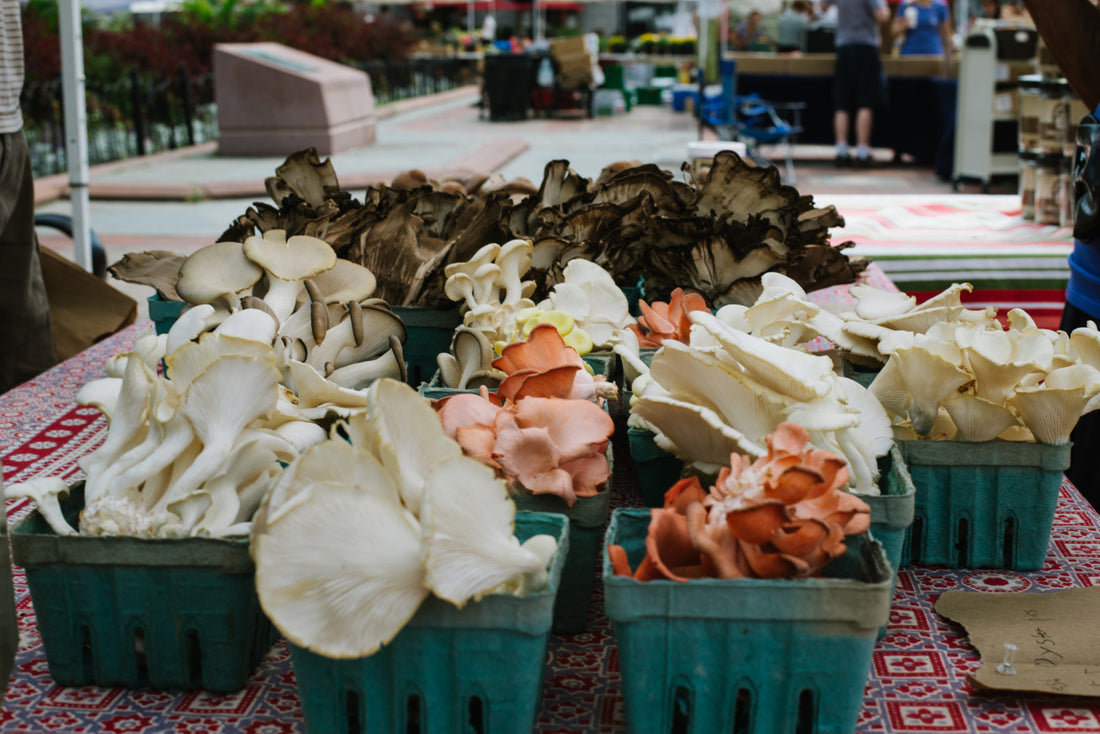There are so many mushroom varieties out there and it is surprising that more of them are not known by a larger audience of people
When it comes to mushroom varieties, most people are familiar with Agaricus bisporus, which is the scientific name for the common button mushroom, crimini, and portobello mushrooms.
However, the amount of mushroom varieties is huge. For instance, if you look at the specialty mushroom field you have lion’s mane, chicken of the woods, shiitake, chanterelle, porcini, morel, blue oyster, pink oyster, yellow oyster, and the list goes on. We offer information below on a variety of edible mushrooms, and we provide mushroom growing kits so you can grow your own at home or commercially.
Mushroom varieties and flavor
There is not just one flavor that mushrooms have.
I’ve heard some people say, “I don’t really like to eat mushrooms”, or, “the texture doesn’t do it for me”, or “I don’t like the flavor of mushrooms.” I am always surprised by these statements because mushrooms have such a vast range of flavor and texture due to the various mushroom varieties.
My recommendation to you: Try as many different edible mushroom varieties as you can and do not lump them all together. Also realize that different ways of cooking mushrooms will lead to different tastes and textures as well.
Check out the video below for more on this topic of mushroom varieties:
https://www.youtube.com/watch?v=XcZZp-e1xhw
2 mushroom varieties worth trying and ways to cook them: Oysters mushrooms & chestnut mushrooms
Oyster Mushrooms: This diverse mushroom comes in many shapes, sizes, and colors. It can be an extremely beautiful mushroom coming in grey, blue, yellow, and pink but also has a GREAT taste. This mushroom is sweeter and has a more subtle taste than shiitake. The caps are the most desirable part and the stems should be chopped finely. Where the stems come together at the base of the mushrooms should be discarded.
Oyster mushrooms are amazing with fried eggs, omelettes, or in pasta dishes. Pink and yellow oyster mushrooms have a much shorter shelf life, be sure to use these within four days of purchasing them. If you are interested in growing mushrooms, oysters are a great one to start as they grow on a wide range of materials and grow very quickly.
Chestnut Mushroom: Chestnuts are the new kid on the block in the specialty mushroom field. These are nutty mushrooms that grow in clusters. The caps can be dry to slightly slimy, which is normal and does not mean they have gone bad.
The entire cap and stem can be used, with the stem being diced into smaller pieces. The strong flavor of this mushroom lend it well to being used in rice dishes and stir fries, giving the meal a stronger umami and nutty flavor and texture. Chestnuts have a beautiful chestnut brown coloring and can have slightly ornamented caps and stems. The baby mushrooms have spikes that stick out from the cap of the mushroom.
To simply saute this mushroom, cut the caps into ¼ inch slices and dice the stems. Throw into a saute pan at medium heat with 2 TBSP of coconut oil. Stir frequently for about 15 minutes until the desired consistency is reached. If you dislike the slimy texture, simply turn the heat up a little and keep cooking them. This can give them a crunchier taste. Chestnut mushrooms, along with most specialty mushrooms, have no fats in them, they have a protein content of 3-5% when fresh.
The absorption of mushroom varieties
Some mushrooms, like lion’s mane, shiitake, and chicken of the woods soak up a lot of flavor, depending on what they are cooked in.
For instance, I recently learned of a recipe from Japan where mushrooms are slowly steeping in soy sauce. You add four tablespoons of sugar, four tablespoons of soy sauce, and around 300 grams of shiitakes, lion’s mane, or oyster mushrooms. Simmer this for 10-15 minutes and the texture of the mushrooms becomes almost like jerky. Add these soy-sauce-simmered mushrooms into a miso soup and you have an incredible dish in your hands.
Mushroom varieties and healthful constituents
The nutritional content and medicinal value of the mushrooms change a lot because not all mushrooms are producing the same chemicals and compounds. There’s a huge range of what we as humans can gain from mushrooms depending on the types being consumed.
For example, lion’s mane mushroom is great for the brain and the gut. Reishi is really good for the immune system and the heart. Maitake is good for blood pressure. The constituents in the different mushrooms are impacting the body in different ways.
So many mushroom varieties, so little time
The big takeaway here: There is not a single mushroom, taste, or flavor. There are so many different types of mushrooms and so much change and difference in them. Don’t lump all mushrooms into one category of flavor. Instead, try getting to know the different edible mushrooms out there, including taste, texture, and ways of cooking the mushroom. This way you can truly experience the various effects of each.
Do you want to try a variety of edible mushrooms? We offer a range of mushroom growing kits so you can grow your own gourmet mushrooms from the comfort of your own home. We also have some tasty dried mushrooms, including the elusive morel mushroom, that can be used in a wide array of dishes.


